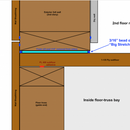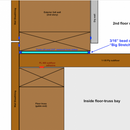Foam “Sill Seal” as a backer sealant rod/spacer
I would like a really good air seal between the bottom plate of the 2nd story to the subfloor.
Although the foam “sill seal” is usually used between PT bottom plate and concrete, I was wondering if it would make sense to use a slightly modified sill-seal between upper story exterior wall and plywood subfloor?
Trimming a 1/2″ off the edge of sill seal will make a 1/4″ gap on both sides, between the bottom plate and the subfloor (diagram attached). I’m thinking that the gap will hold the sealant (Big Stretch) better and allow more elasticity… if a sealant can expand 100%, then a 3/16″ bead could stretch up to 3/8″, while a much smaller bead (standard bottom plate flush to subfloor) doesn’t have much range.
I would like to use the same method of trimming the foam sill-seal to make room for sealant on the lower floor as well… mud sill to the concrete, but will probably use contega or Lexel, for the slightly damp concrete and PT wood.
Does this method make sense? worth it?
Is a foam sill seal on upper floor over plywood acceptable?
I’m hoping that my thinking and explanation makes sense.
(not sure if my image is loading)
Thanks
Peter
GBA Detail Library
A collection of one thousand construction details organized by climate and house part











Replies
Seeing if image as a PDF works?
Peter,
Sill-seal is designed as a capillary break, not an air-sealer. There will be no gap once you stand the exterior walls, which is just as well as you want a continuous load path for the structure that isn't interrupted by compressible materials.
You can use Big Stretch, but more common is a product that doesn't harden, like Tremco accoustical sealant or Contega HF.
Thanks Malcom
So it will compress completely? I thought there would be a gap... maybe the concrete floors I've had in the past were so uneven that it appeared it was not completely compressible.
I thought I was finally getting a handle on all these sealants.
So, "Big Stretch" hardens more than Contega HF? I thought they both remain flexible.
I've gone back and forth in my head over Tremco acoustic. Sounds effective, but smelly and messy (I think you once mentioned getting it all the way home from the jobsite and on to your cat). Finally it hasn't been readily available since I started looking a year ago.
Pete,
And my clothes, and my truck.
I like Big Stretch. It works a bit differently than acoustical sealant. Big Stretch adheres but can stretch. The sealant never hardens, making it more forgiving of movement.
You can compress sill-seal down with your boot, it is very soft.
Where is your primary air-barrier? The sheathing? Drywall? A membrane?
I actually tested the compressibility the other day between 2 blocks of wood and my body weight on top and it remained over 3/16" thick... of course bolts sucking it down and a house on top of it is certainly heavier.
I'm now wishing I had ask the question based on the sill plate over the slab with the "sill seal" between (like it's usually done). Trimming the edges off that sill seal strip so that the sealant can go in the gap on the sides. Maybe a lot of work to avoid having to put sealant on both sides of the sill seal sandwich.
I'm focussing on the drywall as the main air barrier. I would also like to tape the outer sheathing, if the weather allows (1/4 mile from ocean in the PNW). The fluid applied sounds nice and doable in the damp, but is quite expensive.
I'm not sure it's necessary, but would do no harm. I staple the sill-seal to the sill-plates before I install them, rather than put it on the bolts and then push it around. If you do that, and ran it 3/8" in or so, you could quickly trim the other side. There is already a gap at the sub-floor 0r slab, because the bottom plates have eased edges.
I appreciate that clear description. I will use the staple the sill-seal to the plate tip. Feels good to have a plan! Thanks for your time tonight Malcolm.
What I ended up doing...
I ended up really liking the Tremco acoustic sealant. Gave me great confidence that the mud sill will stay sealed to the concrete, even with movement, and was manageable to work with. I liken it to soft hot bubble gum... nice to have some dust or dry dirt near by to neutralize its stickyness if in gets somewhere it shouldn't. . Found the grey JS-773 at S&S sales. I ended up cutting the sill seal in 2 and putting down a central bead of acoustic that connects the concrete to the PT mud sill. (photo). Then trimmed the excess foam sill seal. Then filled in the vertical gaps between mudsill plates with Dymonic 100. After the weight of the house was added, I put a thick bead of Dymonic between the outside concrete and the plywood sheathing. Maybe a little capillary action can now occur from the concrete, through the JS-773 acoustic, into the PT mudsill. But I don't think much if any (and it is PT). And I'm now confident that air and insects will have a hard time traveling through this area.
Notes:
1) Used 3M 90 spray adhesive to temporarily attach the foam to the concrete... before applying acoustic and adding the wood mudsill... prevented breaks in the foam at every mudsill board.
2) Wish I used longer bolts so that I could have mounted the lower mudsill board and then built walls, adding a second bottom plate. Toe nailing studs to the attached mudsill was slow and a bit ugly (and some argue weaker than face nailing)
Note that you don't necassarily have to use sill seal here. I have often recommended HDPE sheet on these forums, but typically for retrofits where the stiffness and slipperyness of the HDPE material helps it to slide into the small gap you get when you jack up sections of the house.
Dana used to like to recommended EPDM roofing membrane for this application. Strips of that are going to be far and away more durable than the pink foam sill seal stuff. You're not going to poke bolts through the EPDM material though (at least not without LOTS of effort), so you'd need to cut holes for those. I'd probably cut + shapes (two slices in the shape a + sign), and let the bolts poke through those. The EPDM is far less likely to tear or bunch up while you're building than the relatively fragile sill seal stuff is.
Bill
I know that this ship has already sailed, but for anyone looking for sill sealing advice I'd recommend this instead: http://www.conservationtechnology.com/building_gaskets.html
They are compressible but also resilient in that they spring back to account for any shifts in the building over time.
As far as sealing the bottom plate on the second floor I don't really see the point? You should have an air barrier somewhere else, like taped Zip sheathing so there isn't an air path at your floor.